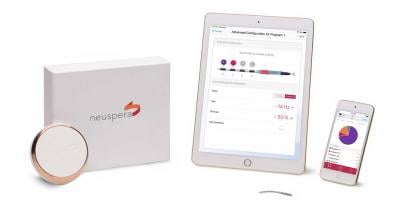Though it be but little, it is fierce: An implant that’s the width of just a few strands of hair is designed to take on the outsized symptoms of chronic pain—and is now cleared by the FDA to do just that.
The peripheral nerve stimulation device comes from Neuspera Medical, which announced the regulatory news Tuesday. Like other PNS systems, Neuspera’s is implanted along the peripheral nerves—that is, those located outside the brain and spinal cord—to block the pain signals that travel along the nerves, but Neuspera has branded its slimmed-down version of the technology as “ultra-miniaturized.”
According to Neuspera, that translates to a footprint about 75 times smaller than those of other PNS devices, which may allow doctors to reach more areas of the peripheral nervous system than they could with larger implants.
“The Neuspera ultra-miniaturized system has the potential to revolutionize the way physicians treat patients battling chronic pain while restoring patients’ health and quality of life,” CEO Steffen Hovard said in the announcement.

Neuspera’s implanted neurostimulator measures just over two millimeters at its widest point. It combines both a receiver and a pulse generator, which receive power from a wireless transmitter to send out electrical pulses to the nerves. The transmitter is externally worn and doesn’t need to be in direct contact with the skin to power the implant, eliminating the need for a separately implanted battery pack.
The entire system can be controlled by both doctors and patients. The clinician programmer software is installed on an Apple iPad and gives doctors a single place to adjust their patients’ treatment regimens, ensure transmitters are properly paired with implants and track the administered neurostimulation therapy. The patient controller, meanwhile, comes in the form of a smartphone app, where users can adjust their own therapy settings—within parameters preset by their doctors—while also monitoring their treatments and tracking the transmitters’ battery levels and other settings.
Neuspera’s PNS system was previously cleared (PDF) by the FDA in August 2021; the company said in Tuesday’s announcement that this month’s clearance is for a “next-generation” version of the technology.
In addition to its use as a peripheral nerve stimulator, Neuspera’s technology is also being adapted as a sacral nerve stimulation system. In that case, the implant would target the nerves responsible for symptoms of urinary urgency incontinence to treat overactive bladder.
The neuromodulation tech hasn’t yet been cleared by the FDA for that indication; it’s currently being studied in a clinical trial that began its second phase last fall. Early results from the feasibility phase of the study that were presented in 2021 showed that 90% of the 34 patients who had been implanted with the system—dubbed Nuvella—saw their urinary incontinence symptoms drop at least 50% at both 6-month and 12-month check-ins after beginning treatment, which consists of two-hour neurostim sessions per day. Plus, just over half of the subjects reported being completely dry by the one-year follow-up.